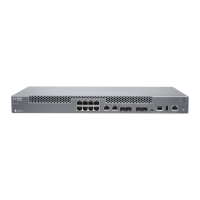to the MX150, see “Pluggable Transceivers Supported on MX150” on page 37. Exceeding
the maximum transmission distances can result in significant signal loss, which causes
unreliable transmission.
Attenuation and Dispersion in Fiber-Optic Cable
An optical data link functions correctly provided that modulated light reaching the receiver
has enough power to be demodulated correctly. Attenuation is the reduction in strength
of the light signal during transmission. Passive media components such as cables, cable
splices, and connectors cause attenuation. Although attenuation is significantly lower
for optical fiber than for other media, it still occurs in both multimode and single-mode
transmission. An efficient optical data link must transmit enough light to overcome
attenuation.
Dispersion is the spreading of the signal over time. The following two types of dispersion
can affect signal transmission through an optical data link:
•
Chromatic dispersion, which is the spreading of the signal over time caused by the
different speeds of light rays.
•
Modal dispersion, which is the spreading of the signal over time caused by the different
propagation modes in the fiber.
For multimode transmission, modal dispersion, rather than chromatic dispersion or
attenuation, usually limits the maximum bit rate and link length. For single-mode
transmission, modal dispersion is not a factor. However, at higher bit rates and overlonger
distances, chromatic dispersion limits the maximum link length.
An efficient optical data link must have enough light to exceed the minimum power that
the receiver requires to operate within its specifications. In addition, the total dispersion
must be within the limitsspecified forthe type of link in Telcordia Technologies document
GR-253-CORE (Section 4.3) and International Telecommunications Union (ITU)
document G.957.
When chromatic dispersion is at the maximum allowed, its effect can be considered as
a power penalty in the power budget. The optical power budget must allow for the sum
of component attenuation, power penalties (including those from dispersion), and a
safety margin for unexpected losses.
Related
Documentation
Calculating the Fiber-Optic Cable Power Budget for an MX150 on page 67•
• Calculating the Fiber-Optic Cable Power Margin for an MX150 on page 68
Calculating the Fiber-Optic Cable Power Budget for an MX150
Calculate the link's power budget when planning fiber-optic cable layout and distances
to ensure that fiber-optic connections have sufficient power for correct operation. The
power budget is the maximumamount of power the link can transmit. When you calculate
the power budget, you use a worst-case analysis to provide a margin of error, even though
all the parts of an actual system do not operate at the worst-case levels.
67Copyright © 2017, Juniper Networks, Inc.
Chapter 8: Transceiver and Cable Specifications

